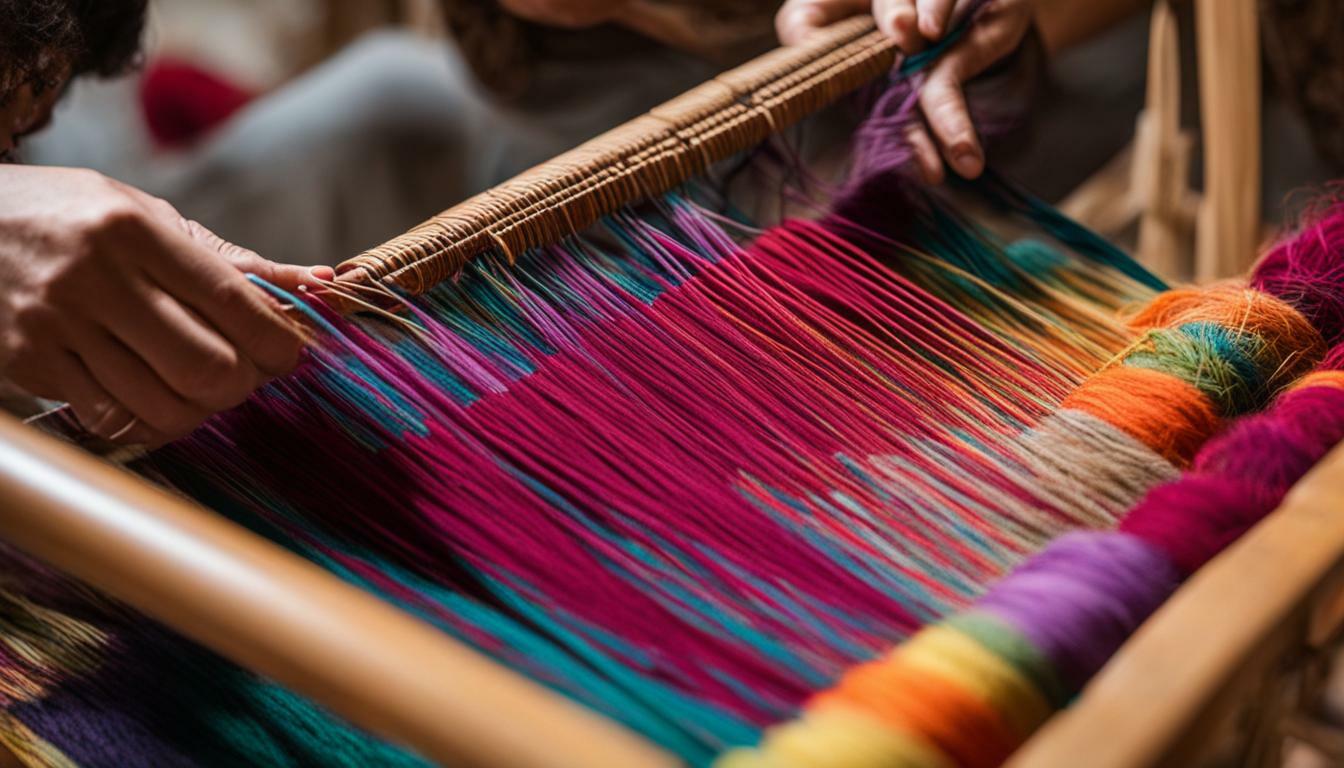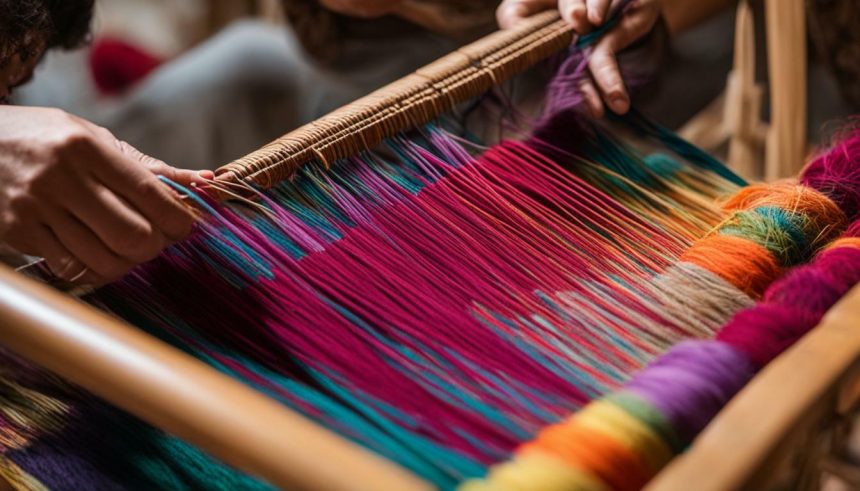Rugs can add a cozy and personal touch to any home decor. Making rugs can be a fun and creative activity to showcase your individuality. Rug-making is a beautiful art that requires patience and creativity. In this section, we will explore the process of making rugs at home and provide step-by-step instructions to help you create beautiful rugs that will be cherished for years.
Key Takeaways:
- Making rugs can be a fun and creative activity.
- Rug-making is an art that requires patience and creativity.
- You can craft stunning rugs in your home using appropriate materials and methods.
- The rug-making process involves designing, preparing, and assembling the rug.
- Proper cleaning and maintenance will preserve the beauty of your rug for years to come.

Choosing the Right Materials
Before you begin your rug-making project, selecting suitable rug-making materials and supplies is crucial. Various types of rug materials are available, and choosing the right one is a significant step in creating a beautiful and durable rug.
Rug-Making Materials
The most common materials used for rug-making are wool, cotton, silk, and synthetic fibers. Wool is the traditional choice known for durability, resilience, and warmth. Cotton is also a popular option for its affordability and versatility. Conversely, silk is exquisite and luxurious but more delicate and expensive than other materials. Synthetic fibers, such as nylon and polyester, are often used for their durability and resistance to stains and fading.
Rug-Making Supplies
Along with the variety of rug-making materials, many supplies are required for the rug-making process. These include a rug hook, rug frame, scissors, and a crochet hook. You may also need a latch hook, tapestry needle, or a shuttle for specific rug-making techniques.
Types of Rug Materials
There are many types of rugs that you can create, such as shag rugs, flatweave rugs, or hooked rugs. The type of rug material you choose will determine the specific rug-making techniques used and the final appearance of your rug. For instance, shag rugs are typically made through knitting and crocheting, whereas hooked rugs are crafted by drawing yarn loops through a woven base.
You can ensure your rug-making project succeeds by selecting suitable rug-making materials and supplies. With so many options available, take the time to research and experiment with different materials and techniques.
Ever wondered who sells area rugs? Follow this link to know more.
Rug-Making Techniques
You can use several techniques to make a rug, including weaving, knotting, and braiding. Each technique has pros and cons, so choosing the one that suits your project best is essential.
Weaving
Weaving is a prevalent method for making rugs, where two sets of threads, the warp, and the weft, are intertwined. The warp threads are set up on a loom, and the weft threads are interwoven. Weaving is an excellent option for creating intricate designs, but it can be time-consuming.
Knotting
Knotting involves tying short pieces of yarn around the warp threads to create a raised pile on the rug’s surface. There are two main types of knots: the symmetrical knot and the asymmetrical knot. Knotting is ideal for creating thick, plush rugs with unique textures and patterns.
Braiding
Braiding uses long strips of fabric or intertwined yarn to create a flat or circular rug. Braided rugs come in various styles and add a cozy, rustic touch to a room. Because braided rugs are made from long strips, they can be assembled quickly and easily.
Whichever technique you choose, rug-making is a fun and rewarding way to personalize your home décor. Experiment with different materials, colors, and patterns to create a rug that reflects your unique style.
Rug Design: Choosing the Perfect Pattern and Color Selection
Designing your rug is an exciting and fulfilling process that allows you to create a unique piece of home decor that perfectly matches your style and preferences. But before you start weaving, you must decide on your rug’s design, patterns, and colors.
Begin by sketching out your rug design on paper. If you’re unsure about your artistic abilities, think about using rug design software or an online platform to produce a digital rendition of your concept. Once you have a clear vision of your rug’s appearance, it’s time to choose your patterns and colors.
Rug Patterns
Rug patterns come in a variety of styles, from traditional to modern. You can choose a pre-designed pattern or create your own. Oriental and Persian rugs are popular choices that feature intricate designs and vivid colors.
On the other hand, if you prefer a more contemporary look, geometric or abstract patterns might be the way to go. Stripes and chevron patterns are also popular options for modern rugs.
Color Selection
Color selection is another crucial aspect of rug design. Think about the room where the rug will be placed and choose colors that complement the space’s existing color scheme. Neutral tones like beige, gray, and cream are versatile and match most decor styles. Vibrant, vivid colors can infuse a room with energy and character, but using them sparingly is best.
Think about utilizing the color wheel to assist in selecting the color scheme for your rug.
Complementary colors (opposite each other on the wheel) create a striking contrast, while analogous colors (next to each other on the wheel) create a harmonious blend. Monochromatic color schemes, using different shades and tints of the same color, can create a subtle and sophisticated look.
Once you have settled on a pattern and color scheme, you can create your unique rug. Let your creativity flow, and enjoy the rug-making process!
Rug-Making Process
Now that you have your design and materials prepared, it’s time to dive into the step-by-step rug-making process. Follow these instructions to create a beautiful rug:
| Step | Instructions |
|---|---|
| 1 | Cut your chosen material into strips of equal width and length. You can use a rotary cutter, mat, scissors, or specialized rug cutter. |
| 2 | Create a base for your rug by weaving, knotting, or braiding your materials. This will serve as the foundation for your rug. |
| 3 | Begin adding your design to the rug foundation. This can be done by either weaving or knotting the materials into the base. Follow your design closely, adding each color and shape as you go. |
| 4 | Once you have completed your design, it’s time to finish off the rug. Use a whip stitch or binding tape to secure the edges and prevent fraying. |
Congratulations, you have completed your handmade rug! It’s important to note that the assembly process may vary depending on the chosen rug-making technique and design. However, these instructions provide a general overview of the steps for a successful rug-making experience.
Take a step back and admire your creation. Your beautiful rug now adds a personal touch and a cozy feel to your home décor!
Cleaning and Maintenance
Now that you have created a beautiful rug, knowing how to clean and maintain it properly is important. With the proper care, your rug can last many years. Here are some tips and techniques to preserve the beauty of your rug:
| Tip | Description |
|---|---|
| Regular vacuuming | One of the easiest ways to keep your rug looking new is by regularly vacuuming it. This helps prevent the buildup of dirt and debris that can damage the fibers over time. |
| Spot cleaning | If you notice a stain on your rug, acting quickly is essential. Blot the stain with a clean, damp cloth, and avoid using harsh chemicals that could damage the fibers. |
| Professional cleaning | It’s a good idea to have your rug professionally cleaned every so often. This can help remove deep-seated dirt and stains that may not be visible on the surface. |
| Rotate your rug | To prevent uneven wear and tear, rotating your rug periodically is a good idea. This can help distribute the weight of furniture and foot traffic more evenly over time. |
With these tips, you can keep your rug looking beautiful for years. Remember to handle your rug carefully and avoid exposing it to excessive sunlight or moisture, which can cause fading or mold growth. By taking good care of your rug, you can enjoy its beauty and comfort for many years!
Conclusion
Now that you have explored the art of rug-making, it’s time to put your skills into practice. Making rugs at home is a rewarding and creative endeavor that allows you to add a personal touch to your home décor.
Remember to choose the suitable materials and supplies before you begin your project. Consider the different rug-making techniques and decide which one suits your needs best. Take time to sketch your design and select the right colors and patterns.
Follow the step-by-step rug-making process, from preparing the materials to assembling the final product. Once your rug is complete, knowing how to clean and maintain it properly is essential. With the proper care, your rug can be a beautiful addition to your home for years.
So what are you waiting for? Start your rug-making journey today, and let your creativity shine!
